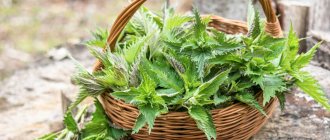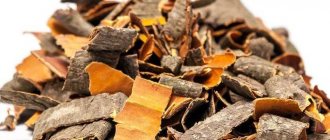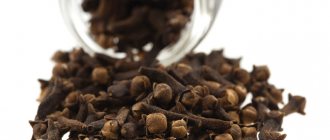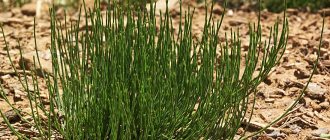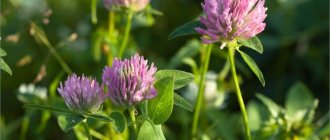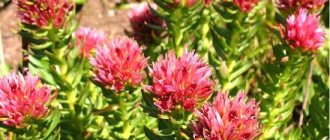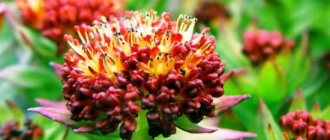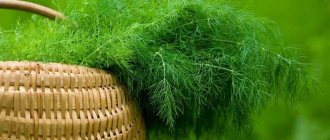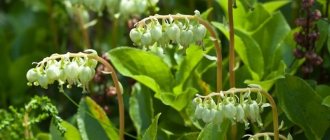Eleutherococcus senticosus (Eleutherococcus senticosus, Aralia Manchurian, devil's bush, Siberian ginseng) is an extremely thorny shrub from the Araliaceae family. The thorns of the plant are thin, long, directed downwards and very brittle. It is impossible to collect raw materials without splinters. Dense, bristling bushes are suitable for growing as a hedge or along a fence.
Eleutherococcus can grow for more than fifty years in one place
Description of the plant (description of the plant and species)
Eleutherococcus is a perennial plant that can grow for more than fifty years in one area. The height of the bush reaches an average of 2.5 m, sometimes up to 5 m. The leaves (main and additional) are light green, pubescent, with a tint and a complex configuration. Each leaf is attached to the branches with a long petiole. One bush has up to 25 branching shoots studded with thorns. Eleutherococcus spiny rhizomes and roots reach a total of 30 m.
The plant blooms in July and has a very strong specific aroma. At the end of the branch an absolutely round umbrella of white small flowers appears. The flowers are of three sexes at the same time: male (yellowish), female and bisexual (light purple). In September-October, instead of inflorescences, black fruit balls with yellow seeds ripen. The inedible berries are called drupes because of the seeds inside. The roots of Eleutherococcus are used as medicine.
This is what the fruit of Eleutherococcus looks like
The scientific study of the root of eleutherococcus was carried out by the Research Institute of Biological Compounds in Vladivostok in the middle of the last century. The reason for starting the study was that during a taiga expedition, scientists noticed increased attention of animals to bushes. They ate not only leaves and thorny branches, but even roots. Research has proven the uniqueness and medicinal properties of Eleutherococcus. At that time, preparations from the bush were used to prepare athletes from the Olympic team, divers, and for the immunity of astronauts after working in extreme extraterrestrial conditions.
Eleutherococcus - what is it?
Eleutherococcus is a genus of plants in the Araliaceae family, which includes about 30 species of thorny shrubs and trees. Found in eastern Asia, from southeastern Siberia and Japan south to the Philippines, central and western China.
Source Wikipedia
This is a thorny shrub plant reaching a height of up to 4 meters.
The leaves are located on long petioles and are palmately compound. The flowers are small, collected in spherical umbrellas. One plant can have female, male and bisexual flowers. The fruits are black, spherical in shape. Ripen in autumn.
Poets write poems about Eleutherococcus. Here is one of them:
Antonina Kukhtina Brushtunova
Where the paths are untrodden, the skies are high, there taiga pharmacies give us miracles.
Eleutherococcus is hiding somewhere in the thicket. He collected all the healing qualities as best he could.
Marmalades, or jam You can’t make it out of it, No, its purpose: To give us health.
Chemical composition
The chemical composition of the bush has been confirmed by scientific research. The roots contain:
- vitamins E, D, A, C, B1.
- eleutherosides - aromatic alcohol;
- essential oils;
- polysaccharides;
- flavonoids;
- tannins;
- sterols (b-sitosterol, daucosterol, triterpenoids);
- vegetable wax;
- coumarin;
- oleic acid.
The most valuable substances - eleutherosides (glycosides) are found only in Eleutherococcus senticosus. The substance increases mental and physical performance, improves metabolism in the body, increases vision and hearing, and blood pressure.
The effect of eleutherococcus on the human body is similar to the effect of ginseng root
Contraindications
Preparations based on Eleutherococcus are contraindicated:
- With high blood pressure;
- Acute heart failure;
- With sleep disorders;
- With increased excitability;
- For arrhythmia;
- During exacerbation of chronic diseases;
- In case of individual intolerance.
Excessive use may cause side effects such as:
- Irritability;
- Sense of anxiety;
- Digestive disorder;
- Insomnia.
If at least one of these symptoms occurs, you must stop taking the drug.
Spreading
Wild eleutherococcus bushes grow in Japan, China, Korea and Russia. In Russia, the plant is found only in the Far East: the Amur region, Primorye, Sakhalin.
Prefers to settle on mountain slopes, along rivers and in sufficiently illuminated forest areas. In cedar, fir and deciduous forests it forms an impenetrable undergrowth on the rich forest floor under the obligatory condition of high humidity. The plant loves partial shade. In a dense and dark forest, individual individuals survive. The closer to the south, the higher the plant climbs. Some species grow in the mountains at an altitude of 1000 m above sea level. Eleutherococcus can be found in your garden. It takes root well if the necessary conditions are created.
Preparations from Eleutherococcus were used to train athletes, divers and for the immunity of astronauts
Customer Reviews
What do real people think about Eleutherococcus?
Feedback on the forum
Feedback on the forum
Feedback on the forum
Feedback on the forum
Feedback on the forum
Feedback on the forum
There are many reviews and they are all positive.
Application
Eleutherococcus is included in the register of medicines in Russia. The effect of Eleutherococcus on the body has led to its use in the following areas:
- Official medicine - in the form of tablets, herbal mixture, Eleutherococcus extract, biostimulant for sports, dietary supplements.
- Cosmetology - for the treatment of hair and skin diseases.
- Veterinary medicine - for the treatment of animals.
- Gardening and landscape design - as decorative park bushes.
- In folk medicine, decoctions and teas are prepared from leaves, shoots and roots that fill a person with vigor.
An unexpected solution to what Eleutherococcus is used for turned out to be:
- energy drinks produced by the food industry;
- in bodybuilding to improve performance;
- if you need to quickly gain weight.
The area of using the beneficial capabilities of the plant is constantly increasing.
Medicinal properties and harm
The effect of eleutherococcus on the human body is similar to the effect of ginseng root. It affects the male and female body differently (the features are presented in the table).
Female body:
- normalizes the menstrual cycle;
- regulates hormonal levels;
- facilitates the course of menopause;
- reduces frigidity (sexual infantilism);
- increases the chance of conception.
Male body:
- improves erection;
- improves blood flow in the pelvis;
- normalizes the psycho-emotional state;
- eliminates physical stress;
- prevention of prostate adenoma (helps alleviate age-related changes).
Eleutherococcus does not act instantly; the therapeutic effect is cumulative. The result should be expected no earlier than 3-4 weeks.
Medicines from Eleutherococcus are also used in the treatment of other diseases:
- infectious diseases (colds, flu, postpartum infections);
- after severe operations and chemotherapy during the recovery period;
- atherosclerosis in the initial stage;
- seborrhea of the skin;
- inflammation of the oral cavity;
- cancer tumors at stages 1-2;
- increased irritability;
- with reduced pressure, it restores the indicator to normal.
In addition to beneficial properties, preparations from Eleutherococcus also have contraindications:
- Eleutherococcus should not be taken while breastfeeding. The active components of the plant enter the milk, and therefore into the baby’s body.
- Not recommended for children under 12 years of age. Until this age, it is taken only as prescribed by a pediatrician.
- You should not take Eleutherococcus if you have hypertension. Drugs for high blood pressure further contribute to its increase.
- Cannot be taken while losing weight. The drugs increase appetite and promote weight gain.
- You should not consume Eleutherococcus in the afternoon if you have insomnia. The medicine activates the action of the central nervous system.
- If you are intolerant to the components of the plant, its use is strictly prohibited.
- For epilepsy.
- For heart failure.
Side effects from taking medications occur with a significant overdose and lead to increased excitability, dizziness, diarrhea, and less commonly, nausea. Benefit and harm are always somewhere nearby, so you should take medications as prescribed by your doctor, if indicated.
Eleutherococcus is included in the register of medicines of Russia
Eleutherococcus[edit | edit code]
Eleutherococcus
Yuzhakov Anton Description Eletherococcus from 0.52 min
Eleutherococcus senticosus
(Eleuterococcus senticosus Maxim). Currently, Eleutherococcus preparations have become widespread and are one of the most widely used adaptogens in various extreme conditions (including when working in the Far North, high mountains, high temperatures and air humidity). The roots of Eleutherococcus contain 7 glycosides (eleutherosides), as well as glucose, sucrose, starch, wax and other substances.
The tonic effect of eleutherococcus manifests itself with long-term use and consists of improving general health. It improves basal metabolism, increases the body's adaptive properties (including resistance to hypoxia), regulates blood sugar, and normalizes the body's condition under stress. In people who take Eleutherococcus preparations for a long time in extreme conditions, compared with the control group, there is a decrease in morbidity, improvement in self-esteem and health status, an increase in vital capacity of the lungs, a more rapid restoration of the initial values of hemodynamic parameters and respiratory rate after physical activity, and a slight increase in muscle strength and static endurance. Eleutherococcus is successfully used to prevent deterioration of health in weather-sensitive people.
A one-time use of Eleutherococcus has a stimulating effect - fatigue and drowsiness are reduced and athletic performance is increased. Eleutherococcus also improves mental performance, and for a long time and without causing negative consequences. At the same time, unlike ginseng, Eleutherococcus primarily increases the speed of performing psychological tests and has little effect on the accuracy of their performance. It is noted that under its influence there is a slight weakening of the irradiation of excitation and an increase in external inhibition. Eleutherococcus is one of the most valuable plant stimulants of physical performance. When exposed to a single dose, there is a shortening (in comparison not only with the control group, but also with groups of athletes who took ginseng and leuzea) of the period of recovery of the parameters of the cardiovascular system, resistance to hypoxemia slightly increases, work is performed with less effort (increases to a lesser extent). residual muscle tone). It should be noted that, as in the case of other adaptogens, the stimulating effect of Eleutherococcus is not significant when performing a maximum power load, but manifests itself mainly against the background of previous fatigue.
Eleutherococcus is used in the form of an alcohol tincture (extract) 15-30 drops per spoon of water 0.5 hours before meals 1-3 times a day. Prophylactic use is recommended for 3-5 days every month. When taking Eleutherococcus extract prophylactically in hazardous production conditions, the course of administration is 1 month and is repeated at monthly intervals.
Eleutherococcus preparations are not recommended to be prescribed at high temperatures, during the acute period of infectious and somatic diseases, and in case of arterial hypertension II B. and higher. High doses of Eleutherococcus extract can cause insomnia, irritability and anxiety in people.
Here is what the famous herbalist and journalist Christopher Hobbs writes about it in his book “Ginseng: The Energy Plant” (Botany Press, 1996):
“Having undergone the most thorough scientific research and tested in practice, Eleutherococcus is consumed daily by millions of Russians. It is used by doctors of the Russian Olympic team, prescribing it, in particular, to weightlifters and runners. Its extract was used by astronauts to adapt the body to the radically different conditions of outer space. It was also regularly taken by mountaineers, sailors and factory workers to enhance adaptation, prevent disease and provide increased endurance.”
Eleutherococcus is an herbal component found in a number of exercise enhancement supplements. Despite its popularity, a recent study examining data on Eleutherococcus found that taking up to 1,200 mg of the supplement daily for one to six weeks had no effect on performance in athletic performance. Some studies have found that this plant can improve the cardiovascular system of athletes and fat metabolism, but their results are imprecise and therefore cannot be considered reliable. Taking Eleutherococcus as a sports supplement is questionable at best.
Collection, preparation and storage
The most useful part of the bush is the root. Features of the workpiece:
- It is better to collect raw materials in late autumn, when the plant has accumulated the maximum amount of useful substances.
- Harvesting should not be carried out after prolonged rains, as the root will have a high water content.
- The process is not very simple due to the presence of thorns. The above-ground part is cut down to get to the root. It is necessary to carefully protect your hands, otherwise the thorns can cause serious inflammation. The roots are located in the ground at a depth of 30 cm, and sometimes become bare and protrude from the ground. In adult bushes, the root is twisted out or the entire root is dug up. In young plants, part of the root should be left for further growth. The wound inflicted on the bush must be covered with earth to protect it from mushrooms and animals.
- Wash the future raw materials, cut into small pieces and dry in a dryer at 80 degrees for an hour.
- Then the raw materials are dried in a ventilated place until ready. The dug up root appears smooth and shiny with slight protuberances.
The leaves are harvested during the flowering period of the bush in August. It should be dried in the shade in a draft, stored in a dry place.
It is impossible to collect raw materials without splinters
How does Echinacea affect the body?
Surely many of you have heard about such a magical remedy for boosting immunity as echinacea. But few people have any idea what it is, how to take it and why it is needed at all.
Echinacea is a plant that is similar in appearance to the familiar aster flowers. It looks nice and is easy to cultivate, so it can easily grow in the summer in a flower bed near your home.
Of particular interest from the point of view of immunity and other medicinal qualities is Echinacea purpurea, a flower with beautiful bright pink petals. It blooms for several months - from July to October. Echinacea came to us from America and, before the widespread use of available antibiotics, was actively used in medicine to treat infections and many other health problems.
The effect of this plant on our body has been well studied. First of all, it should be noted its immunomodulatory, antiviral and anti-inflammatory properties.
Why does Echinacea have such a magical effect on the body? Let's remember the little helpers in the fight against viruses, bacteria, fungi and other enemies of our body - leukocytes. Echinacea significantly increases their number by stimulating hematopoiesis in the bone marrow. The polysaccharides that make up the plant stimulate the production of the cytokine interleukin-1 and increase the phagocytic activity of neutrophils and macrophages - the same gluttons that digest elements foreign to our body. Well, that's not all!
The complex of active ingredients of echinacea accelerates the process of transformation of B-lymphocytes into plasma cells in order to begin producing antibodies and fight viruses and bacteria, and also enhances the activity of T-helpers - assistants who also recognize antigens and help produce antibodies.
As a result, various preparations with Echinacea significantly increase the body's natural defenses. So, if you are sure to get sick during cold and flu season, you should pay attention to this miracle plant. What’s great is that echinacea is suitable for children whose immune system is just developing, and for adults, as well as for older people with already weakened immunity due to the aging of the body.
